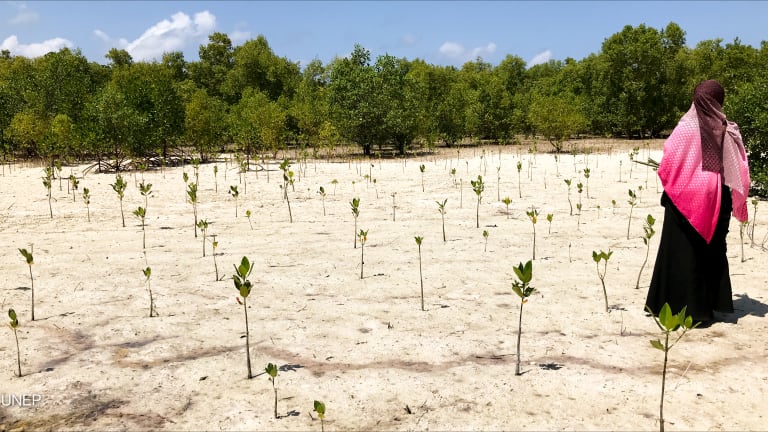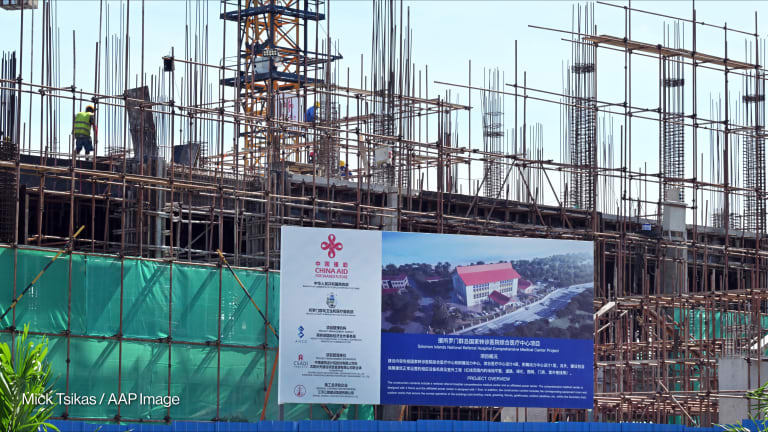Inside the EU plans to spend €26B on development cooperation
The European Union has published its multiannual indicative programs for 2021 to 2027. Devex looks at the data to uncover the agency's geographical and thematic priorities.
In 2020, the European Union announced a stimulus package worth more than €2 trillion. It comprises €1.2 trillion for a Multiannual Financial Framework, or MFF, to cover spending from 2021 to 2027, as well as more than €800 billion to be channeled through the pandemic recovery instrument NextGenerationEU. Included in the MFF is the Neighbourhood, Development, and International Cooperation Instrument-Global Europe — the EU’s main instrument for cooperation and development with partner countries. The bloc’s objectives and priorities for development cooperation with non-European partner countries are defined through so-called multiannual indicative programs, or MIPs, which are financed under NDICI-Global Europe. In December, the EU reported an estimated €26.3 billion in financial cooperation through MIPs, including allocations for country-specific programs from 2021-2024 and regional programs from 2021-2027. However, upon reviewing each strategy document, Devex came up with a slightly higher value: €26.5 billion. MIPs represent only a portion of the EU’s total aid budget, which is now at more than €15 billion annually. The EU provides some figures for total aid over the next cycle in its long-term budget, with €79 billion allocated to NDICI and another €11 billion to humanitarian work, but this is likely not to represent the whole EU aid budget. Spending on development cooperation through MIPs represents around a quarter of the EU’s total development budget over the period extending to 2027. Devex looked into the 88 strategy documents to understand the bloc’s geographical priorities, key sectors, and top programs. Geographical focus The EU identified three regional priorities for its development projects: the Americas and the Caribbean, Asia and the Pacific, and sub-Saharan Africa. Sub-Saharan Africa accounts for the biggest portion of the allocation, with €19.5 billion, or nearly 74%. Of this, €10.2 billion went to a regional program while the rest, worth €9.3 billion, was divided among 44 countries. Asia and the Pacific ranked next, with almost €4.7 billion. A little over €2.3 billion went to a regional program, while €2.2 billion was divided among 23 countries and €117 million went to a program for Pacific island countries. Finally, the Americas and the Caribbean received an allocation worth €2.3 billion. From that amount, almost €1.3 billion went to a regional program and a little under €1.1 billion was divided among 17 countries. Here are the priority areas for the three regional programs: • In sub-Saharan Africa — health, education, governance, the “green transition,” science and technology, economic development, and migration. • In Asia and the Pacific — the environment and climate change, governance, a green economy, migration, social development, trade, and regional cooperation and integration. • In the Americas and the Caribbean — the green transition, digital innovation, economic development, governance, migration, and social development. Among all the countries, Nigeria received the biggest allocation, worth €508 million. This is intended to help the nation transition to a green economy, enhance governance, address migration, and support social development. Other priority countries included Niger, with €503 million; Mozambique, with €428 million; Tanzania, with €426 million; and the Democratic Republic of Congo, with €424 million. Sectoral priorities The EU frames its programs against four thematic areas: human rights and democracy; civil society organizations; peace, stability, and conflict prevention; and global challenges. Each of these has its own priority areas. For the purpose of this article, Devex analyzed the activities under each program and categorized them into nine thematic areas. The green economy accounts for €6.6 billion, or 24.8%, of the EU’s total allocation. Activities under this area focus on supporting countries to transition to a climate-neutral and sustainable economy. This includes improving access to green energy, developing green cities, increasing financial flows to environmental projects, and integrating environmental objectives into economic development goals. Social development ranked next, with €3.6 billion, or 13.4%. This area focuses on activities related to health, education, and reducing inequality, as well as other social services. Governance also received a significant allocation, worth €3.3 billion, or 12.4%. Aside from institutional changes in governance and promoting transparency, this area also supports activities such as increasing citizen participation, promoting peace and security, and protecting human rights. The other thematic areas are: • Economic development, with a €2.8 billion allocation. • The European Fund for Sustainable Development Plus — which was established by the EU to contribute to the United Nations’ 2030 Agenda for Sustainable Development — with €2.3 billion. • Migration, with €2.1 billion. • Support measures, with €1 billion. These include supporting civil society, improving implementation and monitoring of projects, and enhancing the EU’s overall role in development cooperation. • The environment, with €853.4 million. Other sectors, which include science and technology and regional integration, received €4.1 billion. This amount also included several MIPs whose priority areas were listed but whose funding allocations were not specified. Top activities The EU lists several priority areas under each MIP. Here are the biggest activities among the country-specific programs: • €198 million to improve the business climate for increased job opportunities, support the development of “agro-sylvo-pastoral” value chains, which is a system that integrates crops production into livestock production, and contribute to the development of green cities in Niger. • €192 million to improve governance, crisis management, and peace and security in Niger. • €191 million to support green economic growth and improve access to green energy and water in Zambia. • €191 million to promote tourism and sustainable businesses in the agriculture sector and so-called blue economy, which is based on the use of marine resources; improve environmental protection; and support green cities in Tanzania. • €178 million to promote a “circular economy,” create jobs for youths, expand renewable energy, and promote green growth in agriculture and aquaculture sectors in Nigeria. • €172 million to promote the sustainable growth of micro, small, and medium-sized enterprises; support agribusinesses and the agriculture sector; and improve access to water and renewable energy sources in Pakistan. • €169 million to support sanitation, education, and inequality reduction in the Democratic Republic of Congo. • €168 million to develop the agriculture sector and increase access to renewable energy in the Democratic Republic of Congo. • €168 million for job creation, sustainable investments, and the promotion of productive sectors’ sustainable energy, transport, and digital connectivity in Uganda. • €163 million to reduce malnutrition, increase access to education and decent jobs, and support digital transformation in Mozambique. Try out Devex Pro Funding today with a free five-day trial, and explore funding opportunities from over 850 sources in addition to our analysis and news content.
In 2020, the European Union announced a stimulus package worth more than €2 trillion. It comprises €1.2 trillion for a Multiannual Financial Framework, or MFF, to cover spending from 2021 to 2027, as well as more than €800 billion to be channeled through the pandemic recovery instrument NextGenerationEU.
Included in the MFF is the Neighbourhood, Development, and International Cooperation Instrument-Global Europe — the EU’s main instrument for cooperation and development with partner countries.
The bloc’s objectives and priorities for development cooperation with non-European partner countries are defined through so-called multiannual indicative programs, or MIPs, which are financed under NDICI-Global Europe. In December, the EU reported an estimated €26.3 billion in financial cooperation through MIPs, including allocations for country-specific programs from 2021-2024 and regional programs from 2021-2027. However, upon reviewing each strategy document, Devex came up with a slightly higher value: €26.5 billion.
This story is forDevex Promembers
Unlock this story now with a 15-day free trial of Devex Pro.
With a Devex Pro subscription you'll get access to deeper analysis and exclusive insights from our reporters and analysts.
Start my free trialRequest a group subscription Printing articles to share with others is a breach of our terms and conditions and copyright policy. Please use the sharing options on the left side of the article. Devex Pro members may share up to 10 articles per month using the Pro share tool ( ).
Miguel Tamonan is a Senior Development Analyst at Devex, where he analyzes data from public and private donors to produce content and special reports for Pro and Pro Funding readers. He has a bachelor’s degree in Political Science with a Major in International Relations from the Polytechnic University of the Philippines.








